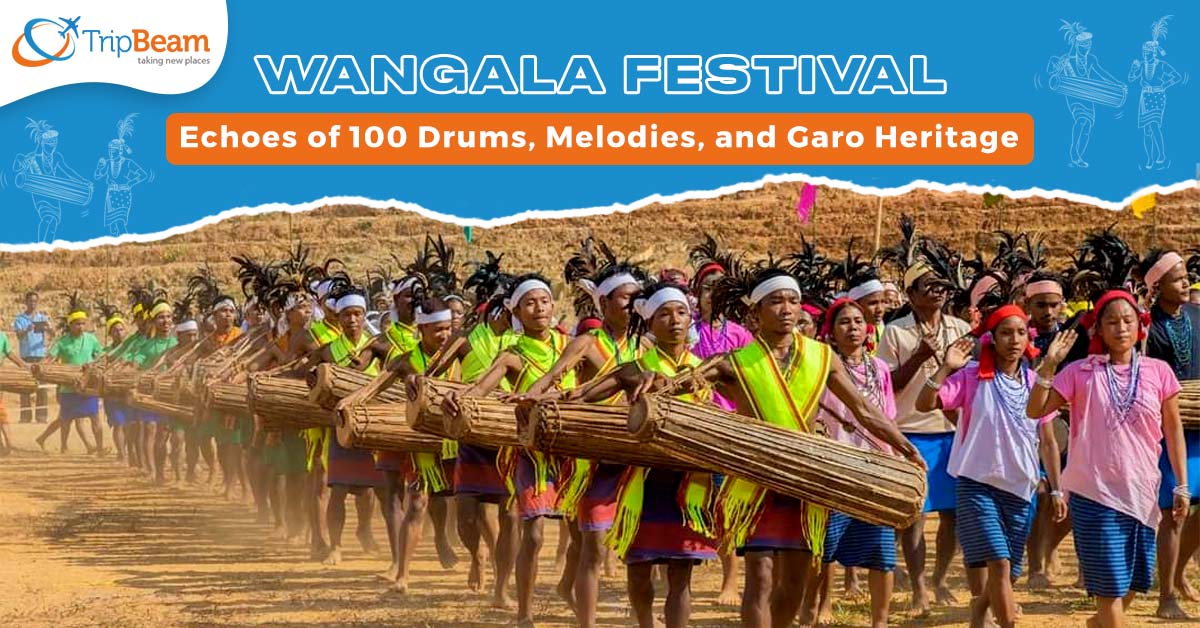

India is home to a variety of harvest festivals, during which time different regions give gratitude for productive crop years. The Garo tribes celebrate the harvest every year in November with the Wangala Festival. Its main focus is on worshiping Misi Saljong, the Sun God, and giving reverence to him for a bountiful harvest. The Garo community uses this event as an opportunity to showcase its customs and rituals, which are a part of their traditional tribal culture. This article will look at the Wangala Festival’s cultural and historical significance as well as the customs and festivities that surround it. So, prepare to book cheap flights to India from Canada with Tripbeam, and let’s explore Wangala Festival: Echoes of 100 Drums, Melodies, and Garo Heritage.
Indian traditional gods are deeply ingrained in the culture. Though many places observe this practice, Garos places the highest value on it! The Wangala celebration is an opportunity to give thanks to Misi Saljong, the God of the Sun. It was originally held in 1967 and is also known as the 100 Drums Festival. The Asanang site was the ideal location to give gratitude to the sun god for a plentiful crop.
While Meghalaya is the state where this holiday is most well-known, it is also celebrated in other parts of the country. The Garo communities in Assam, Nagaland, Bangladesh, and Assam likewise commemorate Wangala with immense grandeur and traditions. The state government is sponsoring the event in an attempt to preserve and promote the rich cultural legacy of the Garo people.
The vibrant and magnificent Wangala festival is a wonderful fusion of tradition and modernity. The use of wooden musical instruments is a well-known practice among several communities in Northeast India. The instruments and distinctive rhythms of India are highly praised in the Wangala festival. The Wangala festival typically lasts two days, but it can extend up to seven days. Also, you can browse Tripbeam to book business class flight tickets to India at reasonable prices.
The event begins with a customary ritual on its first day. It’s called Rugala, and it takes place in the chief’s home, Nokma. Throughout the ceremony, a priest burns incense sticks and pours rice beer. As you observe this beautiful activity, you feel a variety of emotions.
On this day, a special rice paste is prepared to embellish the chief’s house. Everyone in the village uses the paste to decorate their dwellings. Numerous other important ceremonies of the Garo community are observed on this day as well.
Although the first day of Wangala is dedicated to using rituals to establish a connection with God, the second day is incredibly colorful! Kakkat, the second day, is also important to Garos from different contingents.
What makes the ensemble stand out is everyone’s feathered headgear. From young children to elderly family members, Wangala Day 2 captures everyone in utter happiness! The day is welcomed by the Garos’ cheerful Wangala dance. It’s practically not essential to sing any song because the percussion creates blissful tunes. Furthermore, the dance configuration starts with two parallel lines and develops into numerous variations.
The main goal of the Wangala dance is to honor agricultural operations’ journey. The tribes present various images of harvesting, warding off evil, and carrying out daily rituals. The dance will astound you since it necessitates a spiritual bond with agricultural pursuits as well as a sense of community. It is said that during this time, the hills renew and relax in anticipation of the impending winter.
The Wangala Festival is a happy celebration that spans multiple days and features dancing, music, and cultural activities. The Nokma’s arrival, with its people dressed in traditional garb, electrifies the atmosphere with expectation and excitement, laying the groundwork for an amazing show. The parade winds past the exuberant audience, symbolizing a peaceful blending of celebration and history. The Wangala Festival captures the essence of community, tradition, and joy through this magnificent entry and the cultural celebration that follows, making it an exciting and memorable event for everyone who takes part.
The Wangala Festival has grown in popularity over time, attracting artists from areas outside of Garo Hills. Dance groups from several regions, including Greater Mymensingh in Bangladesh, Karbi Anglong, and Nagaland, participate in the celebrations, adding a multicultural and varied element to the occasion. This inclusive approach not only brings more energy to the celebration but also highlights its role as a platform for intercultural exchange, bringing together various communities to celebrate shared customs, thereby bridging geographical gaps and promoting a collective celebration of diversity.
Do you know why the 100 oval-shaped Drums Festival is the most well-known aspect of the Wangala Festival? The Garo people inhabit many hilly regions of Meghalaya, and each one of them represents its locality. This indicates that there are ten unique troupes, each with its color scheme. Each of the ten troupes consists of ten drummers. The festival derives its name from the fact that 100 drums are played in a heart-meltingly melodic rhythm. Additionally, you can check out Tripbeam.com to grab the cheapest flights from USA to India.
So, get ready to enter the rhythmic trance that 100 drums have inspired. Book last minute flights from Canada to India with Tripbeam and prepare to dance along with the Garos.
Also Read: 50th Rose Festival begins in Chandigarh | Tripbeam.ca
Tell us more details to help better





